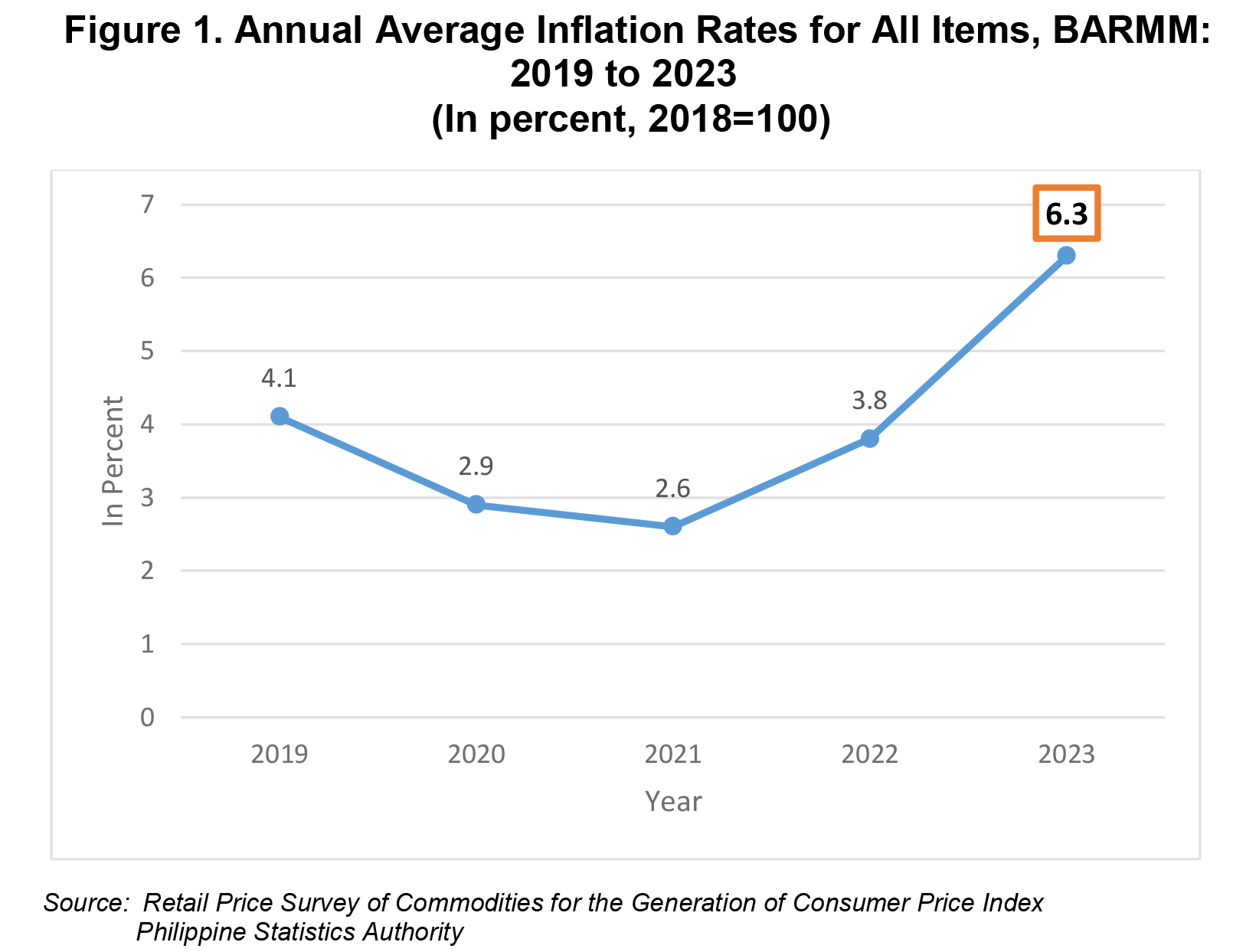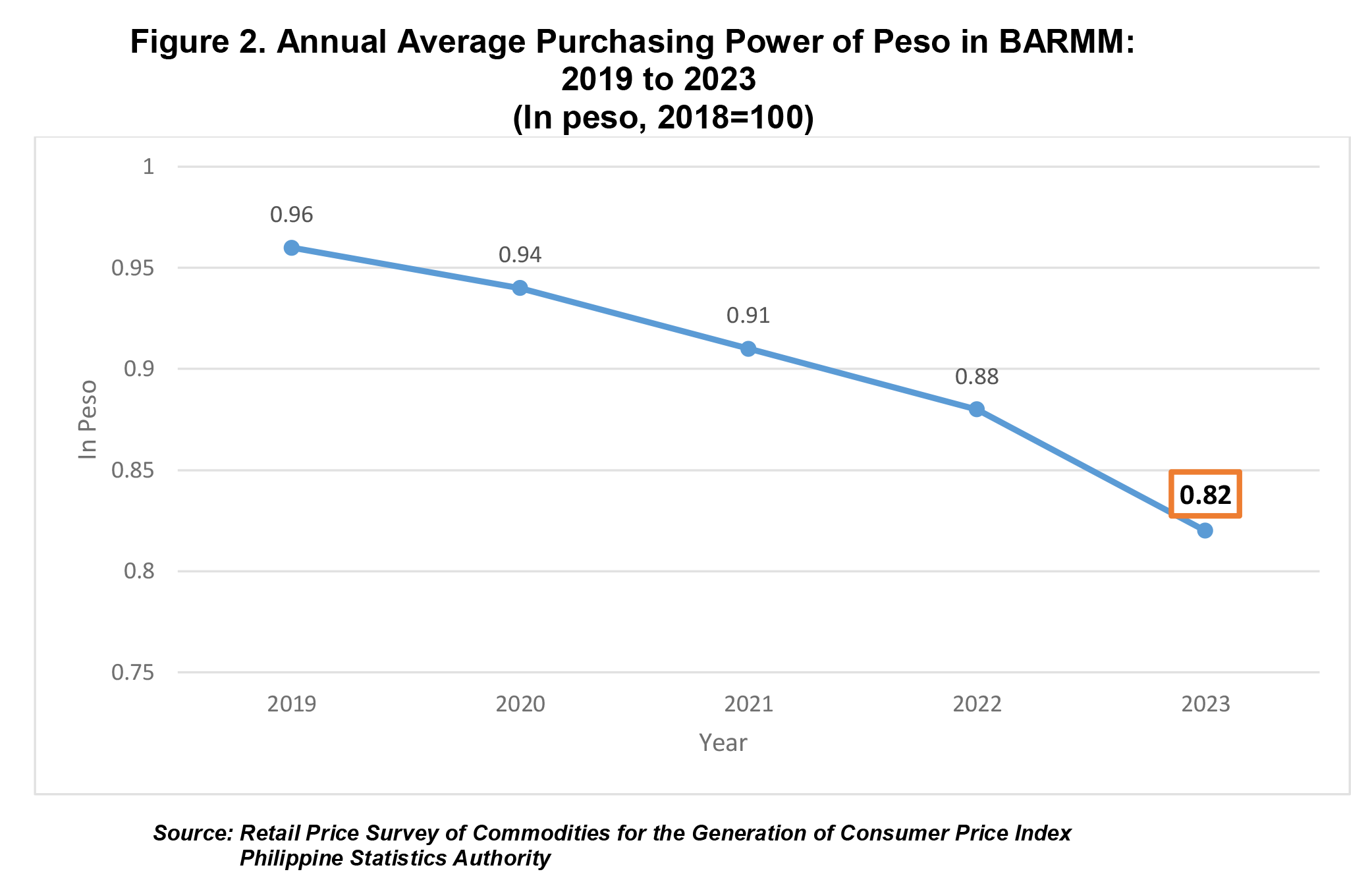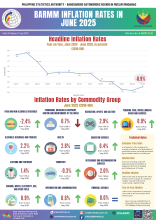A. ANNUAL AVERAGE INFLATION RATE

The Bangsamoro Autonomous Region in Muslim Mindanao had an annual average inflation rate of 6.3 percent in 2023, which was higher than its rates in 2022 (3.8 percent), 2021 (2.6 percent), 2020 (2.9 percent), and 2019 (4.1 percent). Table 1 shows that the annual averages for BARMM and its provinces, including its Highly Urbanized City (HUC), increased in 2023. Tawi-Tawi had the highest annual average inflation rate in 2023 at 7.9 percent, followed by Basilan at 7.2 percent, Lanao del Sur at 5.2 percent, Maguindanao at 7.9 percent, and Sulu at 3.8 percent. Meanwhile, Cotabato City also recorded a higher annual average inflation rate in 2023 at 4.8 percent.

In 2023, the annual average inflation rates of the following commodity groups were higher when compared to their respective rates in 2022:
a. Food and Non-Alcoholic Beverages, 7.8 percent
b. Alcoholic Beverages and Tobacco, 8.1 percent;
c. Clothing and Footwear, 3.2 percent;
d. Furnishings, Household Equipment and Routine Household Maintenance, 3.3 percent;
e. Information and Communication, 0.7 percent;
f. Recreation, Sport and Culture, 4.8 percent;
g. Education Services, 5.0 percent;
h. Restaurants and Accommodation Services, 11.8 percent
i. Personal Care, and Miscellaneous Goods and Services, 3.6 percent.
Meanwhile, the commodity groups that posted decreases from their previous annual average inflation rates were the following:
a. Housing, Water, Electricity, Gas and Other Fuels, 3.0 percent;
b. Health, 0.8 percent;
c. Transport, 0.6 percent;
d. Financial Services, 0.0 percent.

B. ANNUAL AVERAGE INFLATION RATES FOR FOOD ITEMS
For food commodities, the annual average inflation rates increased to 7.8 percent in 2023, from 3.8 percent in 2022 and 2.0 percent in 2021.
The increase in the region’s food annual average inflation was mainly brought about by the higher annual average indices for Cereals and cereal products (ND) at 8.5 percent, Vegetables, tubers, plantains, cooking bananas, and pulses at 3.7 percent, and Fish and other seafood (ND) at 3.7 percent, (see Table 3). Also contributing to the uptrend in the overall annual average inflation during the year were the higher annual increments in the average indices of the following food commodity groups as compared with their previous year’s annual average inflation rates:
a. Rice, 9.3 percent;
b. Flour, Bread and Other Bakery Products, Pasta Products, and Other Cereals, 7.4 percent;
c. Meat and other parts of slaughtered land animals, 7.5 percent;
d. Milk, other dairy products and eggs, 5.8 percent;
e. Sugar, Confectionery and Desserts, 22.3 percent.
On the other hand, the following food groups posted deceleration from their previous annual average inflation rates. These were:
a. Corn, 2.7 percent;
b. Oils and Fats, 4.9 percent;
c. Fruits and Nuts, negative 0.2 percent; and
d. Ready-made food and other food products n.e.c,, 1.1 percent.

C. PURCHASING POWER OF PESO
Purchasing Power of Peso (PPP) is inversely related to inflation rate. Thus, as the inflation rate increases, PPP declines, as shown in Figure 2. In 2023, the annual average PPP in BARMM is at PhP 0.82.

TECHNICAL NOTES:
Consumer Price Index (CPI)
The CPI is an indicator of the changes in the average retail prices of a fixed basket of goods and services commonly purchased by households relative to a base year.
Uses of CPI
The CPI is most widely used in the calculation of the inflation rate and purchasing power of peso. It is a major statistical series used for economic analysis and as a monitoring indicator of government economic policy.
Computation of CPI
The computation of the CPI involves consideration of the following important points:
a. Base Period
The reference date or base period is the benchmark or reference date or period at which the index is taken as equal to 100.
b. Market Basket
A sample of the thousands of varieties of goods purchased for consumption and services availed by the households in the country selected to represent the composite price behavior of all goods and services purchased by consumers.
c. Weighting System
The weighting pattern uses the expenditures on various consumer items purchased by households as a proportion to total expenditure.
d. Formula
The formula used in computing the CPI is the weighted arithmetic mean of price relatives, the Laspeyre’s formula with a fixed base year period (2018) weights.
e. Geographic Coverage
CPI values are computed at the national, regional, and provincial levels, and for selected cities.
Inflation Rate
the rate of change of the CPI expressed in percent. Inflation is interpreted in terms of declining purchasing power of peso.
Headline Inflation
refers to the rate of change in the CPI, a measure of the average standard “basket” of goods and services consumed by a typical family.
Purchasing Power of Peso
shows how much the peso in the base period is worth in the current period. It is computed as the reciprocal of the CPI for the period under review multiplied by 100.
Note: The dataset used in the special release is exclusive for BARMM provinces including Cotabato City and excluding 63 barangays.
ENGR. AKAN G. TULA
OIC-Regional Director

